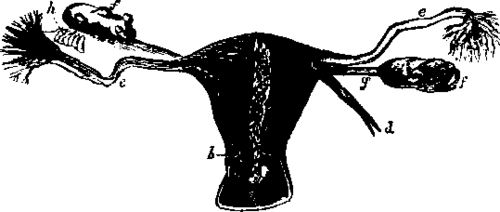202. The Ovum Or Egg
Description
This section is from the book "Animal Physiology: The Structure And Functions Of The Human Body", by John Cleland. Also available from Amazon: Animal Physiology, the Structure and Functions of the Human Body.
202. The Ovum Or Egg
The Ovum Or Egg, in birds and various other animals, is enlarged by the incorporation with it of a great amount of matter which does not undergo fertilization, useful only as material for the nourishment of the young animal. But the mammalian ovum is a structure microscopically minute, which is only discovered by scientific observation.
The human ovum is about 1/120 of an inch in diameter. It consists of a transparent envelope, the zona pellucida, surrounding a granular yelk; and, in the interior of this, to one side, is a clear nucleus called the germinal vesicle, with a distinct nucleolus, the germinal spot. The ova are developed within organs called ovaries, which are placed one on each side in the lower part of the abdomen, and are flattened oval bodies, about an inch and a half long, invested with peritoneum. Each is attached by a fibrous cord to the upper part of the uterus.

Fig. 141. Uterus and Ovaries from the front, a. Vagina with ob uteri depending into it; b, cavity of cervix uteri, with rugose mucous membrane; c, cavity of fundus uteri, exposed in the right half; d, round ligament of uterus; e, e, Fallopian tubes, the right one laid open; f, f, ovaries; g, round ligament of ovary; h, parovarium.
Continue to:
